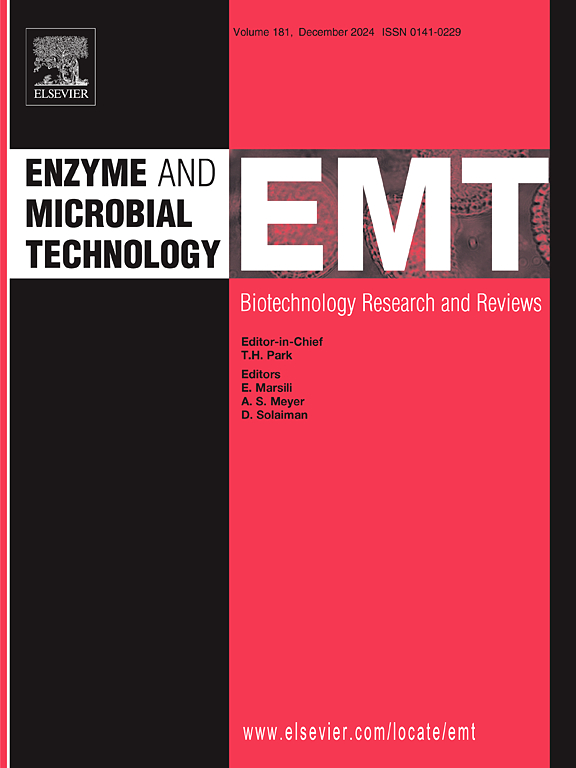揭示大肠杆菌和犊牛肠道碱性磷酸酶在磷酸钙合成中的作用。
IF 3.4
3区 生物学
Q2 BIOTECHNOLOGY & APPLIED MICROBIOLOGY
引用次数: 0
摘要
酶催化合成磷酸钙是制备生物医学用钙基纳米材料的一种很有前途的方法。这项工作的目的是确定当碱性磷酸酶催化反应时形成的磷酸盐类型,并确定天然生物聚合物在磷酸钙形成中的作用。在这项研究中,我们分析了在碱性磷酸酶存在下从大肠杆菌或小牛肠道合成的磷酸钙,分析了所获得的纳米颗粒,并通过功能组成、元素比例和形态对它们进行了比较。由于所有的合成都是在Tris缓冲液中添加MgCl2进行的,最终耗尽的羟基磷灰石含有镁。研究发现,在最初的24 h内,反应产物的形态由酶源以及反应混合物中其他生物聚合物(特别是腐植酸)的存在决定。在7天的反应过程中,得到了空心的羟基磷灰石纳米球,作为大肠杆菌和小肠碱性磷酸酶的最终产物。当腐植酸加入到反应混合物中,在24小时的反应中观察到分离的羟基磷灰石球体。当Mg离子作为缓冲成分存在于反应混合物中时,它们被均匀地结合到生成的磷酸钙的结构中。所获得的数据可用于理解生物物体的钙化过程,并将磷酸钙的酶合成方法应用于生物医学应用。本文章由计算机程序翻译,如有差异,请以英文原文为准。
Unraveling the role of E. coli and calf intestinal alkaline phosphatase in calcium phosphate synthesis
The enzyme-catalyzed synthesis of calcium phosphate is a promising method for producing calcium-based nanomaterials for biomedical applications. The purpose of this work was to determine the type of phosphate that forms when alkaline phosphatase catalyzes the reaction, and to identify the role of natural biopolymers in calcium phosphate formation. In this research, we analyzed calcium phosphates that were synthesized in the presence of alkaline phosphatase from either E. coli or calf intestinal, analyzed the obtained nanoparticles and compared them by functional composition, elemental ratio, and morphology. Since all syntheses were performed in Tris buffer with the addition of MgCl2, the final depleted hydroxyapatite incorporated magnesium. It was found that in the first 24 h, the reaction product form is determined by the enzyme source as well as the presence of other biopolymers (in particular, humic acid) in the reaction mixture. Hollow nanospheres of the depleted hydroxyapatite were obtained as a final product for both E. coli and calf-intestinal alkaline phosphatase during a 7-day reaction. When humic acid was added into the reaction mixture, separate spheres of the depleted hydroxyapatite were observed during a 24-h reaction. When Mg ions are present in the reaction mixture as a buffer component, they are evenly incorporated into the structure of the resulting calcium phosphate. The data obtained can be useful in understanding the calcification process of bioobjects and in applying the enzymatic method of calcium phosphate synthesis to biomedical applications.
求助全文
通过发布文献求助,成功后即可免费获取论文全文。
去求助
来源期刊

Enzyme and Microbial Technology
生物-生物工程与应用微生物
CiteScore
7.60
自引率
5.90%
发文量
142
审稿时长
38 days
期刊介绍:
Enzyme and Microbial Technology is an international, peer-reviewed journal publishing original research and reviews, of biotechnological significance and novelty, on basic and applied aspects of the science and technology of processes involving the use of enzymes, micro-organisms, animal cells and plant cells.
We especially encourage submissions on:
Biocatalysis and the use of Directed Evolution in Synthetic Biology and Biotechnology
Biotechnological Production of New Bioactive Molecules, Biomaterials, Biopharmaceuticals, and Biofuels
New Imaging Techniques and Biosensors, especially as applicable to Healthcare and Systems Biology
New Biotechnological Approaches in Genomics, Proteomics and Metabolomics
Metabolic Engineering, Biomolecular Engineering and Nanobiotechnology
Manuscripts which report isolation, purification, immobilization or utilization of organisms or enzymes which are already well-described in the literature are not suitable for publication in EMT, unless their primary purpose is to report significant new findings or approaches which are of broad biotechnological importance. Similarly, manuscripts which report optimization studies on well-established processes are inappropriate. EMT does not accept papers dealing with mathematical modeling unless they report significant, new experimental data.
 求助内容:
求助内容: 应助结果提醒方式:
应助结果提醒方式:


